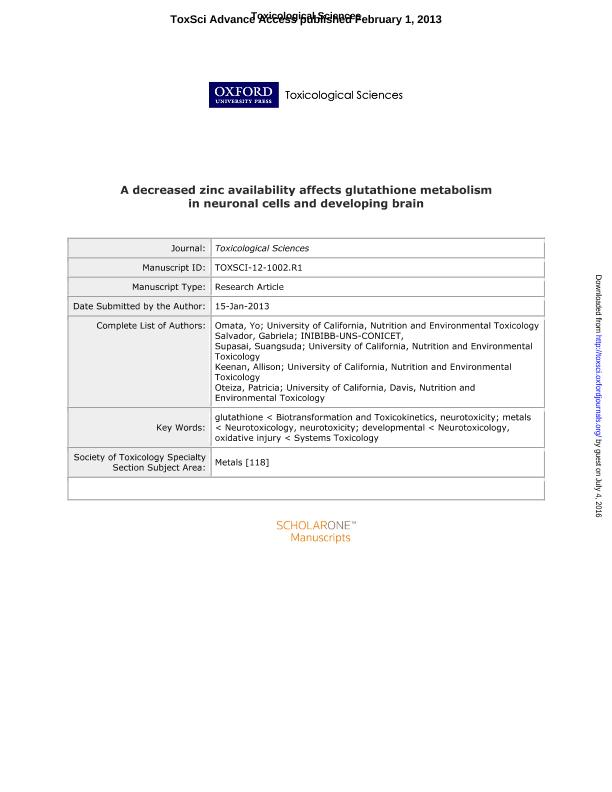Mostrar el registro sencillo del ítem
dc.contributor.author
Omata, Yo
dc.contributor.author
Salvador, Gabriela Alejandra

dc.contributor.author
Supasai, Suangsuda
dc.contributor.author
Keenan, Allison H.
dc.contributor.author
Oteiza, Patricia Isabel
dc.date.available
2016-03-09T19:18:39Z
dc.date.issued
2013-01
dc.identifier.citation
Omata, Yo; Salvador, Gabriela Alejandra; Supasai, Suangsuda; Keenan, Allison H.; Oteiza, Patricia Isabel; A Decreased Zinc Availability Affects Glutathione Metabolism in Neuronal Cells and in the Developing Brain; Oxford University Press; Toxicological Sciences; 133; 1; 1-2013; 90-100
dc.identifier.issn
1096-6080
dc.identifier.uri
http://hdl.handle.net/11336/4716
dc.description.abstract
Department of Nutrition and Department of Environmental Toxicology, University of California, Davis, California 95616. Abstract A deficit in zinc (Zn) availability can increase cell oxidant production, affect the antioxidant defense system, and trigger oxidant-sensitive signals in neuronal cells. This work tested the hypothesis that a decreased Zn availability can affect glutathione (GSH) metabolism in the developing rat brain and in neuronal cells in culture, as well as the capacity of human neuroblastoma IMR-32 cells to upregulate GSH when challenged with dopamine (DA). GSH levels were low in the brain of gestation day 19 (GD19) fetuses from dams fed marginal Zn diets throughout gestation and in Zn-deficient IMR-32 cells. γ-Glutamylcysteine synthetase (GCL), the first enzyme in the GSH synthetic pathway, was altered by Zn deficiency (ZD). The protein and mRNA levels of the GCL modifier (GCLM) and catalytic (GCLC) subunits were lower in the Zn-deficient GD19 fetal brain and in IMR-32 cells compared with controls. The nuclear translocation of transcription factor nuclear factor (erythroid-derived 2)-like 2, which controls GCL transcription, was impaired by ZD. Posttranslationally, the caspase-3-dependent GCLC cleavage was high in Zn-deficient IMR-32 cells. Cells challenged with DA showed an increase in GCLM and GCLC protein and mRNA levels and a consequent increase in GSH concentration. Although Zn-deficient cells partially upregulated GCL subunits after exposure to DA, GSH content remained low. In summary, results show that a low Zn availability affects the GSH synthetic pathway in neuronal cells and fetal brain both at transcriptional and posttranslational levels. This can in part underlie the GSH depletion associated with ZD and the high sensitivity of Zn-deficient neurons to pro-oxidative stressors.
dc.format
application/pdf
dc.language.iso
eng
dc.publisher
Oxford University Press

dc.rights
info:eu-repo/semantics/openAccess
dc.rights.uri
https://creativecommons.org/licenses/by-nc-sa/2.5/ar/
dc.subject
Zinc
dc.subject
Gluthatione
dc.subject
Oxidative Stress
dc.subject
Brain
dc.subject
Dopamine
dc.subject
Neuron
dc.subject.classification
Bioquímica y Biología Molecular

dc.subject.classification
Ciencias Biológicas

dc.subject.classification
CIENCIAS NATURALES Y EXACTAS

dc.title
A Decreased Zinc Availability Affects Glutathione Metabolism in Neuronal Cells and in the Developing Brain
dc.type
info:eu-repo/semantics/article
dc.type
info:ar-repo/semantics/artículo
dc.type
info:eu-repo/semantics/publishedVersion
dc.date.updated
2016-03-30 10:35:44.97925-03
dc.journal.volume
133
dc.journal.number
1
dc.journal.pagination
90-100
dc.journal.pais
Reino Unido

dc.journal.ciudad
Oxford
dc.conicet.avisoEditorial
This is a pre-copyedited, author-produced PDF of an article accepted for publication in Toxicol. Sci. following peer review. The version of record Toxicol. Sci. (2013) 133 (1): 90-100. doi: 10.1093/toxsci/kft022 is available online at: http://toxsci.oxfordjournals.org/content/133/1/90
dc.description.fil
Fil: Omata, Yo. University of California. Department of Nutrition and Department of Environmental Toxicology; Estados Unidos
dc.description.fil
Fil: Salvador, Gabriela Alejandra. Universidad Nacional del Sur; Argentina. Consejo Nacional de Investigaciones Científicas y Técnicas. Centro Científico Tecnológico Bahía Blanca. Instituto de Investigaciones Bioquímicas Bahía Blanca (i); Argentina
dc.description.fil
Fil: Supasai, Suangsuda. University of California. Department of Nutrition and Department of Environmental Toxicology; Estados Unidos
dc.description.fil
Fil: Keenan, Allison H.. University of California. Department of Nutrition and Department of Environmental Toxicology; Estados Unidos
dc.description.fil
Fil: Oteiza, Patricia Isabel. University of California.Department of Nutrition and Department of Environmental Toxicology; Estados Unidos
dc.journal.title
Toxicological Sciences

dc.relation.alternativeid
info:eu-repo/semantics/altIdentifier/url/http://www.ncbi.nlm.nih.gov/pmc/articles/PMC3627551/
dc.relation.alternativeid
info:eu-repo/semantics/altIdentifier/url/http://toxsci.oxfordjournals.org/content/133/1/90.long
dc.relation.alternativeid
info:eu-repo/semantics/altIdentifier/doi/http://dx.doi.org/10.1093/toxsci/kft022
dc.relation.alternativeid
info:eu-repo/semantics/altIdentifier/issn/1096-6080
Archivos asociados
